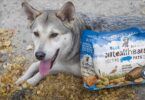What looks like a harmless autumn snack could secretly threaten your furry friend. While squirrels stash oak tree nuts for winter, should pet owners worry when their dogs sniff these natural treasures?
Every fall, countless oak seeds blanket parks and backyards. These nutrient-rich nuggets sustain wildlife but hide dangers for curious canines. Veterinary experts like Dr. Jerry Klein warn that even small quantities may cause poisoning or intestinal blockages.
The risks go beyond simple stomach upset. Tannins in raw acorns disrupt digestion, while their tough shells can damage tissues. Size matters too—smaller breeds face greater hazards from swallowing whole nuts.
This guide explores why something so natural requires caution. You’ll learn to spot warning signs and protect your companion during peak acorn season. We’ll break down science into practical tips, combining veterinary insights with real-world safety strategies.
Keep reading to discover how autumn walks can stay safe without sacrificing outdoor fun. Let’s decode the hidden risks beneath those iconic oak tree caps.
Understanding Acorns and Oak Trees
The mighty oak’s signature fruit plays a vital role in forest ecosystems. These seed capsules mature through summer, transforming from green to brown as autumn approaches. Each nut-like fruit contains a single seed protected by a woody cupule—nature’s perfect packaging for tree reproduction.
Nature’s Nutrient Powerhouses
Wildlife depends on these energy-rich fruits for survival. Squirrels hoard them, deer forage for them, and birds like jays disperse them. This natural food source helps maintain balanced ecosystems across North America’s woodlands.
Oak Biology Through the Seasons
Oak species produce varying quantities of fruits in cyclical patterns called mast years. Some years yield bumper crops, while others see sparse harvests. Leaves from these trees generally pose fewer risks than their fruits, though certain parts contain tannins that affect taste and digestibility.
Fall brings increased ground coverage of these natural objects, creating seasonal challenges for outdoor pets. Understanding their growth patterns helps owners anticipate exposure risks during daily walks or backyard playtime.
The Risks of Acorn Poisoning for Dogs
Autumn’s crunchy temptations hide unseen dangers for four-legged explorers. While oak nuts sustain wildlife, their chemical makeup poses unique threats to pets. Veterinary studies reveal that even occasional nibbling may trigger serious health complications requiring swift action.
Tannins and Their Toxic Effects on Canine Health
Oak fruits contain concentrated tannic acid—a natural compound that protects plants from predators. When ingested, these tannins bind to proteins in a pet’s digestive system. This reaction often causes inflammation, reducing nutrient absorption and irritating stomach lining.
Prolonged exposure to tannins may overwhelm a dog’s metabolism. Veterinary toxicologists note that untreated cases could lead to cellular damage in filtering organs. Bloodwork irregularities linked to liver or kidney stress typically appear within 24-48 hours after consumption.
Recognizing Symptoms and Signs of Poisoning
Initial warning signs include excessive drooling and refusal to eat. These often progress to vomiting episodes containing plant material or bile. Pet owners might notice trembling or unusual lethargy as the body reacts to toxins.
Severe reactions involve bloody stool or dark urine, signaling potential organ distress. Time matters—animals showing these advanced symptoms need immediate veterinary evaluation. Early intervention dramatically improves recovery chances before systemic complications develop.
Monitoring outdoor play during peak fall months helps prevent emergencies. Quick removal of oak debris from yards reduces accidental ingestion risks. Always consult a veterinarian if unusual behaviors emerge after woodland walks.
Can Dogs Eat Acorns? What You Need to Know
Pet owners often overlook the physical dangers hidden in nature’s snacks. Beyond chemical toxicity, oak nuts present mechanical risks that demand immediate attention. Their dense structure and irregular shape create multiple threats during exploration.
Choking Hazards and Gastrointestinal Blockages
Hard shells can lodge in throats or intestinal pathways. Smaller breeds face higher risks due to narrower airways. Fragmented pieces may scrape digestive linings, causing internal injuries.
Severity of Reactions: From Upset Stomach to Organ Damage
Mild cases might involve temporary stomach discomfort. Larger quantities could trigger vomiting or diarrhea. Without treatment, accumulated fragments might puncture tissues, leading to systemic infections.
When to Seek Immediate Veterinary Care
Watch for gagging sounds or pawing at the mouth. Labored breathing and refusal to drink signal emergencies. Professionals use X-rays to locate obstructions, followed by IV fluids or surgery if needed.
Never attempt home remedies like induced vomiting. Contact your vet clinic immediately if ingestion occurs. Swift action often prevents lasting damage, especially within the first six hours.
Other Tree Nuts and Their Impact on Dog Health
While autumn brings colorful foliage, it also drops hidden hazards beneath beloved shade trees. Many pet owners don’t realize common nuts pose similar dangers to oak fruits. Understanding these risks helps create safer environments for four-legged companions.
Comparing Risks: Acorns Versus Other Common Nuts
Almonds and cashews aren’t toxic but carry high fat content. Overconsumption may trigger pancreatitis—a painful pancreatic inflammation. Macadamia nuts rank higher in toxicity, potentially causing weakness or tremors within hours.
Hard-shelled varieties like pecans present physical dangers. Their jagged edges can tear intestinal linings or cause obstructions. Mold growth on damp walnuts produces tremorgenic mycotoxins, leading to seizures if ingested.
Some owners occasionally offer plain peanuts or pistachios as treats. These should always be unsalted, shell-free, and given sparingly. Even “safe” options become risky when consumed in large quantities or with added seasonings.
Veterinary nutritionists emphasize that nuts lack nutritional benefits for pets. Their calorie density contributes to weight gain, while choking hazards persist across all types. Sticking to vet-approved snacks prevents emergencies and supports long-term health.
Preventive Measures and Emergency Treatments
Proactive steps can transform autumn adventures into safe experiences for four-legged companions. By combining smart routines with quick response plans, owners reduce risks while preserving outdoor joy.
Effective Prevention Tips During Acorn Season
Leash guidance proves essential in parks with heavy oak tree coverage. Choose walking routes away from clustered fallen nuts, especially after windy days. Trainers recommend reinforcing “leave it” commands using high-value treats as positive reinforcement.
Yard maintenance matters too. Use specialized nut rollers to clear debris weekly, particularly under mature trees. Make sure play areas remain free from natural hazards that might tempt curious sniffing.
What to Do if Ingestion Occurs
Watch for sudden changes like abdominal pain or repeated vomiting. These symptoms often signal tannin-related issues. Stay calm and prevent further snacking by moving your pet from the area immediately.
Contact your veterinarian or animal poison control without delay. Make sure to note approximate quantities consumed and any visible reactions. Professionals may recommend monitoring or urgent treatment based on size and health history.
Preventive care drastically lowers emergency risks. Regular ground checks and prompt action keep tails wagging safely through every season.
Safeguarding Your Pet: Final Guidelines
Nature’s autumn bounty requires smart vigilance for pet owners. While oak trees sustain ecosystems, their fruits demand caution around curious companions. Tannins in raw acorns threaten digestion, while jagged shells risk internal injuries—even small amounts may trigger vomiting or organ stress.
Compared to other nuts, oak fruits pose unique dangers. Unlike fatty almonds or toxic macadamias, these carry dual threats: chemical irritation and physical hazards. Watch for early signs like drooling or lethargy, escalating to dark urine or abdominal pain in severe cases.
Act fast if exposure occurs. Note symptoms, prevent further snacking, and contact your vet immediately. Keep emergency numbers handy during fall walks—timely care often prevents liver or kidney complications.
Create safer spaces by clearing oak debris from yards and reinforcing “leave it” commands. Regular monitoring helps catch issues before they escalate. Remember: prevention beats treatment when dealing with seasonal hazards.
When autumn leaves fall, let awareness rise. Bookmark this guide, share it with fellow pet lovers, and always prioritize professional consultation. Your furry friend’s health thrives on informed choices and swift action.
FAQ
Are acorns safe for pets to consume?
No. Acorns contain tannins that can cause stomach pain, vomiting, or liver/kidney damage in dogs. Their hard shells also pose choking risks or intestinal blockages.
What makes oak tree parts dangerous for dogs?
Both fallen acorns and oak leaves release toxic tannic acid when chewed. This compound disrupts digestion and may lead to severe dehydration or organ failure in extreme cases.
How quickly do poisoning symptoms appear after ingestion?
Signs like lethargy, diarrhea, or abdominal discomfort often surface within 6–24 hours. Severe reactions—including bloody stool or collapse—require immediate emergency vet intervention.










Leave a Comment